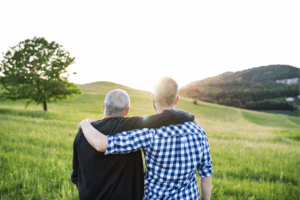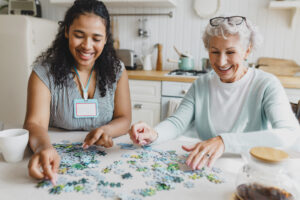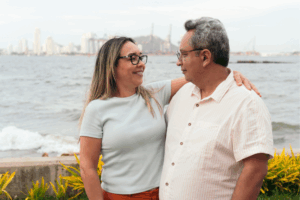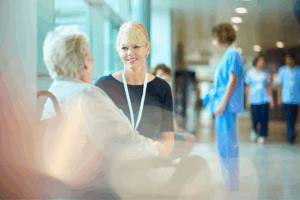Danna Faulds writes warm, heartfelt poems about her experiences with yoga, and her personal discoveries of spirituality.
“It is a wonder
how a simple stretch
deepens breath,
and an elegantly held pose
grows to touch the
whole of me.”
The beautiful journey that she describes is even more special because there are almost no limits to who can participate. Yoga is a very adaptable exercise offering immeasurable benefits for the body, mind—and spirit.
Yoga calls on us to move with the breath, and to be very mindful of our body alignment, but it also helps to bring us back to the present moment. It helps to slow down the mind and to create more space and awareness for the spirituality underlying our experiences. Remember that your experience of yoga is a personal one, so open yourself to the messages your body and spirit offer as you adapt this practice to fit your own journey.
Even if you or your aging loved one has a difficult time getting up and down from a chair or the floor, learn to practice while seated. Here you will find a short chair yoga practice with simple movements designed to lubricate the joints, stretch the muscles, and strengthen the core for improved balance.
If you have osteoporosis, do not perform this practice. Some yoga postures can be very beneficial for osteoporosis, and others can put further stress on the bones. It’s best to find a class designed for older adults with a certified teacher who can guide you to care for your body safely with yoga.
A Home Chair Yoga Practice
Yoga is an exploration of movements that increase awareness and suppleness in your whole being, so there is no need to approach these poses with any expectations of how they should look or feel. To try the exercises at home, you’ll need a chair without wheels (or a wheelchair with the brakes on), preferably one with a relatively firm seat. An upholstered armchair with a lot of give under your weight will not support your posture, and may put extra stress on your back. If the chair is too high for you to feel comfortable with your feet planted on the floor, try placing a wide book or two under them so that you feel stable and grounded. Chair yoga sometimes incorporates other props, like straps or blocks, but this practice won’t call for anything but you and your solid seat.
If any of these movements don’t work for your body, skip over them and try a different one. If you’re guiding an aging adult through this practice, you may want to sit in a chair facing them, so they can listen for your cues and watch as you find the poses yourself.
Lateral Bends to Create More Space for the Breath
- Scoot forward a bit in your chair, if you’re able, and sit with a tall spine, stretching up through the top of your head and down through your tailbone.
- Rest your left hand on the left edge of your seat, or you can even reach down to hold onto the leg of your chair. Let your right arm float out to the right side and sweep up, up, until it reaches toward the ceiling.
- Staying tall, you can slowly begin to reach your right fingertips toward the ceiling on your left. As you do this, you’ll feel your left waist folding a bit and your whole right side, from your hip through your rib cage and your arm, stretching long.
- Hold this stretch for a couple of breaths, or come back to center and release your right arm whenever you need to.
- Now, repeat these movements on the other side, starting with the right hand resting on the side of the chair and the left arm reaching up and over with a long spine.
- Do this about three times on each side, alternating.
Simple Movements to Help Lubricate and Free the Joints
- Again, feel your spine stretching tall, up and down.
- Keeping your chin parallel with the floor, slowly turn your head to look to the left and then to the right. Do this a couple more times, stopping if you begin to feel dizzy.
- Then, wiggle and stretch your fingers; it doesn’t quite matter how this looks—just that you’re bringing movement into the finger joints.
- Relax your hands and bend your elbows, reaching hands toward shoulders. Straighten again, then do this a few more times.
- Release your arms down again, and shrug your shoulders up, then let them drop, up, and drop.
- Bring your right hand down to your right knee. Keeping the left foot on the ground, lift the right leg and, with the help of your hand there, slowly swing it over to your right side, then back to center and repeat a few times. Next, bring the right foot back to the ground and do the same on the left side.
- Reach for your right thigh with both hands for support as you gently kick the foot forward, extending the leg. Let it slowly bend back to rest. Repeat a few times. Do the same with the left leg, loosening up the knee joint.
- Now, with both feet planted on the floor and hands resting on your legs, begin to lift your heels as much as possible. Your toes and the balls of your feet will still touch the ground, and just your heels lift. Bring your feet flat again, and let the toes and balls of the feet begin to lift instead. Alternate lifting heels and toes a few times.
- Finally, wiggle your toes. Just like with your fingers, the goal is simply to find movement in the toes as much as possible.
- You can repeat these joint exercises as many times as you feel comfortable, being mindful not to tire yourself out before you continue with the rest of the practice.
Spinal Twist to Relieve Tension in the Back and Neck
- If you’re in a chair without arms, turn yourself 90 degrees to the right, so that your knees are both hanging off the right side of the chair.
- Find your long spine, letting your arms float up overhead so your fingers reach toward the ceiling.
- Begin to turn your torso to the right, reaching your hands down to grab the chair back.
- You have the option here of turning your head even a bit further to look over your right shoulder.
- Hold for a few deep breaths, then slowly release.
- Maintaining a tall spine the whole time, turn 180 degrees, so your knees are both hanging over the left side of the chair and repeat the movements in this direction.
- If you are in a chair with arms or a wheelchair, continue to sit with your knees facing forward, lift your arms up overhead from there, and then—with your spine as long as you can make it—turn to the right, reaching for the arm of the chair and looking over your shoulder if it’s comfortable. Hold for a few breaths, and then repeat on the left side.
Bellows Pose to Stimulate the Breath, Abdominal Muscles, and Digestion
- Sit facing straight ahead again and reach your arms up overhead, fingers toward the ceiling.
- Take a deep breath in and, as you breathe out, begin to lift your right knee up toward your chest even as your hands come down to grab your thigh or shin briefly.
- With your next inhale, release the leg down and reach the arms up again.
- Exhale, lifting the left knee up toward your chest and reaching your hands down to grab that leg.
- Inhale, left leg releases and arms reach up again.
- Now, with your exhale, let your hands come down to rest on your thighs, and reach your heart forward and down, folding your torso over your lap as far as is comfortable.
- And inhale back up, reaching the arms high, getting ready for another round.
- Repeat this—right knee in, left knee in, fold toward both knees—with the flow of your breath a few times in full.
- If you find it uncomfortable to lift and reach for your legs, you can perform this same sequence by exhaling and folding the chest gently over the right knee, and then the left, and then centered over both.
Letting Your Body Absorb the Benefits
Yoga offers a wonderful opportunity to experience your body, to connect with your breath, and to commit to loving care, for yourself or your aging loved one. There’s a tradition after any yoga practice of letting yourself be very still and relaxed for a few minutes in order for your body, mind, and spirit to assimilate all of the healing energy it has attracted and created. You can do this right from your chair.
Imagine all the vertebrae throughout your back, and feel them stacked one on top of the other so that you can rest on your bones, rather than having your muscles holding you up. If you happen to have a yoga mat, it can serve as a great prop. Roll it up, then stand it up tall on the seat between your spine and the chair. Scoot yourself back in the seat, so the middle of your back is pressed right up against it, then relax into the roll. Allow yourself these few sacred minutes just to rest. You might even reflect on Danna Faulds’ poem as you sink into your soft body and breath.
Yoga’s Reach
It is a wonder
how a simple stretch
deepens breath,
and an elegantly held pose
grows to touch the
whole of me.Like sugar stirred into tea,
the potency
of yoga spreads
from body into mind
and heart, revealing
an ocean of energy
that heals and opens,
holds me close
and sets me free
all in the same moment.
(by Danna Faulds, From Root to Bloom, Peaceable Kingdom Books, 2006, p. 19)
Each time you do this practice, it will be a new journey of flexibility, strength, and connection. The more you practice, the deeper your body-mind-spirit connection will become. Just like any other exercise that calls on us to build strength, endurance, or mental clarity, yoga’s benefits expand as you become more familiar and more in tune with yourself.
If you’re interested in other ways to stimulate the body, mind, and spirit, Institute on Aging offers myriad online resources, programs, and services. Contact us today to learn how we can help enrich life’s journey for you or your aging loved one.







